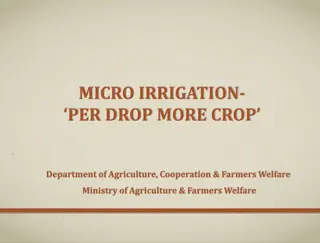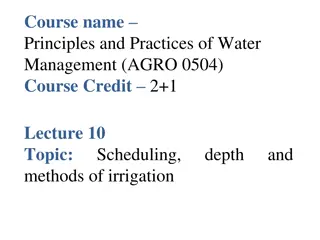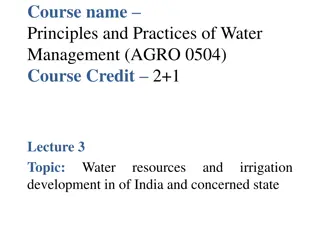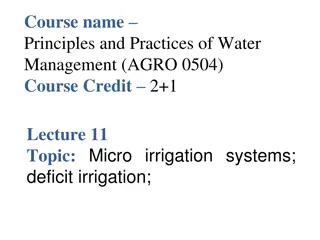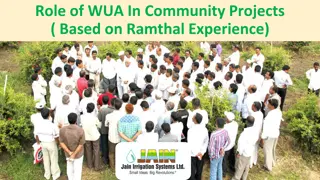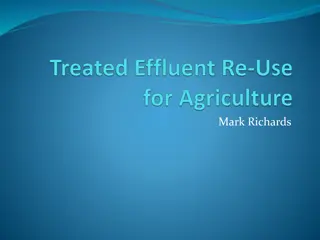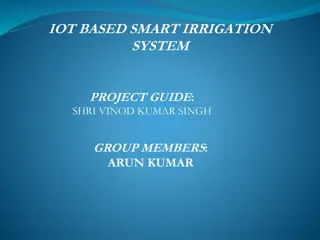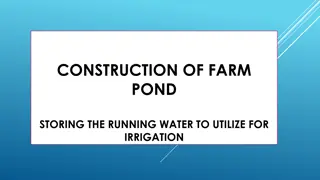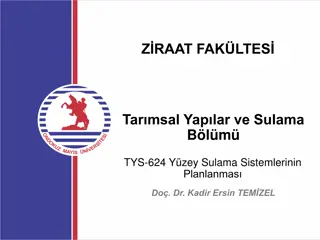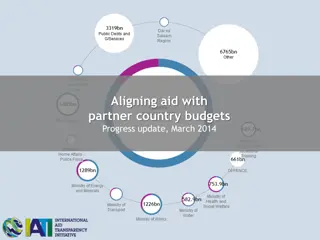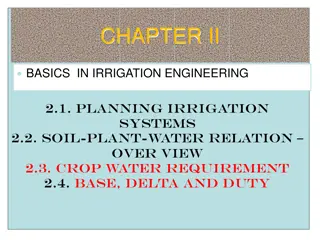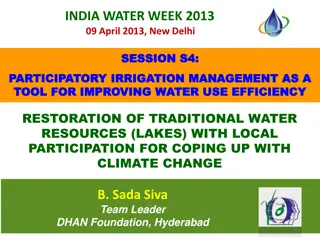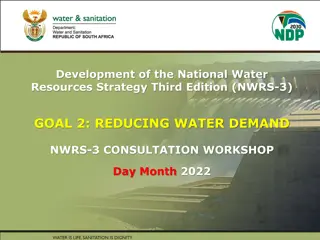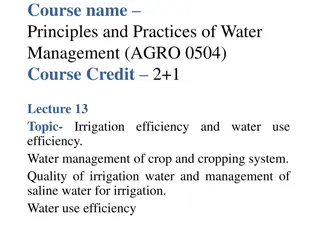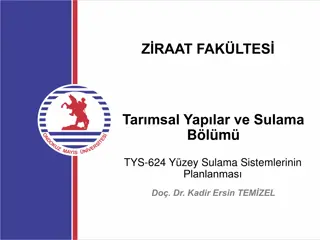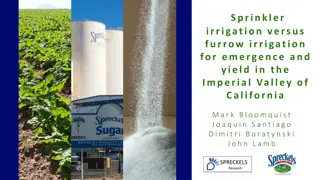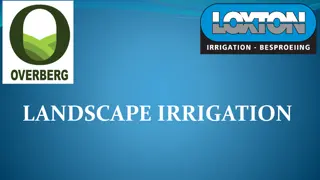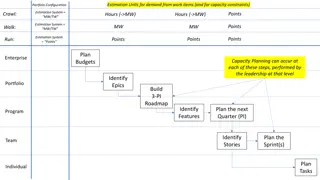Simplified Landscape Irrigation Demand Estimation: SLIDE Rules for Water Budgets
Simplified Landscape Irrigation Demand Estimation presents a comprehensive guide on managing urban landscape water use efficiently. Collaborators from various institutions contribute to addressing the challenges posed by drought and climate change. The document explores plant water demand, atmospheric conditions, water agency stakeholders, and the concept of Reference Evapotranspiration (ETo) to estimate plant water requirements. The content emphasizes the importance of understanding and measuring atmospheric demand to optimize water usage for different plant types in urban environments.
Download Presentation

Please find below an Image/Link to download the presentation.
The content on the website is provided AS IS for your information and personal use only. It may not be sold, licensed, or shared on other websites without obtaining consent from the author. Download presentation by click this link. If you encounter any issues during the download, it is possible that the publisher has removed the file from their server.
E N D
Presentation Transcript
Simplified Landscape Irrigation Demand Estimation: SLIDE Rules for Landscape Water Budgets and Allocations Roger Kjelgren Utah State University Dept. Plants, Soils, & Climate
Collaborators Trans-institutional colleagues Dennis Pittenger, University California Cooperative Extension Richard Beeson, University Florida Research & Extension Ctr. Thayne Montague, Texas Tech University Center for Water Efficient Landscaping, USU Kelly Kopp, Professor Larry Rupp, Professor Paul Johnson, Professor Joanna Endter-Wada, Professor Diana Glenn, Research Associate Adrea Wheaton, Research Associate
Background Drought, climate change managing landscape water is a major policy and program management challenge for water agencies California social engineering - how people relate to water via urban, irrigated landscape Per parcel/lot landscape water demand Per capita (people) water demand
Plant Water Demand transpiration When soil water is not limited, water demand is a function of atmospheric conditions
Water agency stake: Water use Water use water supply Water use Irrigate to refill root zone Root depth: irrigate before plant performance is affected; desiccation tolerance
Urban Plant Water Demand Demand = plant water use in response to atmosphere We can easily measure atmospheric demand solar radiation, humidity, wind, temperature But measuring plant response to atmospheric demand is not easy Instead, we measure atmospheric demand over standardized plant surface: cool season turfgrass ETo is information about atmosphere, not about plant response Atmospheric demand measured over a standardized surface = Reference evapotranspiration, or ETo
Urban Plant Water Demand ETo link to plant water demand: Plant Factor (PF), not crop coefficient, that adjusts ETo downward ETo x PF = estimated plant water demand for a given plant type Example, Salt Lake City Yearly ETo =40 inches PF cool season turf =0.8 Plant water demand = 40 inches x 0.8 = 32 inches Until now, no PF s for non-turf landscape plants
ETo and potential water demand for different plant types Non- turf Turf Desert But how much?
SLIDE Simplified Landscape Irrigation Demand Estimation, based on ASABE S623 Fraction of ETo (Plant Factor) to estimate water use yet maintain acceptable appearance of established landscape plants Recommended Plant Factor Turf-Cool Season 0.8 Turf-Warm Season 0.6 Non-turf/woody plants-Humid 0.7 Non-turf/woody plants-Arid 0.5 Desert plants 0.3
ETo x PF = water demand for different plant types X 0.5 PF non-turf = 20 inches X 0.8 PF turf = 32 inches X 0.3 PF desert plants = 12 inches Salt Lake City Seasonal ETo = 40 inches
SLIDE Rules Three Applications WaterMAPS - tool for direct use by water agencies Identify customers with high capacity to conserve: applying water to landscapes in excess of plant water demand Educate customers about their landscape irrigation practices compared to actual plant water demand Assess water conservation customer and program performance Aid landscape design community to design low water landscapes to meet specific water allocations/budgets Provide minimum irrigation guidelines to keep high value landscape elements (e.g., trees) alive during drought
WaterMAPS Water Management Analysis and Planning Software Integrates various databases to compare actual landscape water use (derived from meter data) to estimated demand (needs) based on ETo x PF First studied in Wasatch Front suburbs (Layton, West Jordan) then expanded to three other entities in metropolitan region (Logan, Weber Basin, Salt Lake City) Difference between actual landscape water use and estimated demand (needs) = capacity to conserve WaterMAPS automates calculation of capacity to conserve for all parcels in a water providers service area
West Jordan, Utah Residential Potable Water Use, 2000; n=2,090 homes Seasonal Landscape Water Applied 140 120 ETo = 39 inches 100 (inches) 80 60 31 inches turf water demand (uniform irrigation) 40 19 inches trees 20 12 inches desert plants 0 0 10000 20000 30000 40000 50000 Landscape Area, ft2
Weber Basin WCD, Utah, Residential Secondary Water Use, 2012; n=859 homes 200 Seasonal Landscape Water Applied 180 160 ETo = 40 inches 140 120 (inches) 100 80 60 32 inches turf water demand (uniform irrigation) 40 20 inches trees, 12 inches desert plants 20 0 2000 7000 12000 17000 22000 Landscaped Area, ft2
Identifying Capacity to Conserve through LIR Landscape Irrigation Ratio (LIR) at the parcel scale LIR less than 1 = Efficient Between 1 and 2 = Acceptable Between 2 and 3 = Inefficient Greater than 3 = Excessive Landscape Water Use _________________ (estimated from analysis of meter data) LIR= ________________________________________________ (estimated from classified airborne multispectral imagery and localized ETo rates modified by relevant landscape plant factors) Landscape Water Need (per unit of landscaped area)
Customer Education Secondary Users Three neighborhoods with secondary water in Weber Basin WCD service district Smart meters installed winter 2011/2012 Received reports on LIR/Capacity to Conserve since 2012 seen significant water savings
Water Conservation Evaluation: Participants Did people save water? Logan City Residential customers Received free irrigation system evaluation (Water Check) Calculated LIR/Capacity to conserve before and after the Water Check
Water Conservation Evaluation: Program How can the program respond to customer performance? Free Water Checks only worked with small number of customers Customers who increased use, or had high LIR and no change, need different approach
SLIDE Rules Application #2 Tool for the Landscape Design Community: Hydrozones based on Water Demand
Tool for Landscape Design Community Landscape architects/designers key to creating low water landscapes with identifiable water savings SLIDE/ASABE S623 standardizes two key processes Hydrozones as smallest landscape area managed by irrigation zone Plant cover <80%, water demand that of isolated plants Water demand for isolated plants based on cross-section crown area To meet water allocation/budget, designers now have two standardized tools: species with lower PF, using fewer plants (<80% cover)
Design Tools: Hydrozoning Hydrozone controlled by a single irrigation valve Plant species with highest Plant Factor dictates the overall zone PF (don t mix turf and desert plants) Low plant cover by widely spaced plants, or by creating dense plant oases within larger non- plant area
Design Tools: Hydrozoning Dense planting water demand: area x 0.5 PF Low density planting water demand of either isolated plants or plant cluster Oasis incomplete plant cover; high density (>80%) areas imbedded in hardscape Isolated plant water demand: Circle area x 0.5 PF
Design of Things to Come: CA Regulations for New Landscapes
SLIDE Rules Application #3 Keeping High-Value Landscapes Alive During Drought
Responding to Drought During drought, turf can be sacrificed (or removed) What happens to trees important 5-10 times more valuable per ft2 than turf Special attention needed for trees previously imbedded in and irrigated with turf Again, estimate water demand of isolated trees
Keeping Urban Trees Alive During Drought During drought, customers will likely focus on keeping trees alive Estimate water demand of isolated tree based on 2- dimensional shape (mostly circle, but also triangle and rectangle) Web site for calculating water demand of isolated tree and irrigation schedule: http://files.radiantm.com/tree- irrigation/
Summary SLIDE simplifies how to estimate landscape water demand for three general plant types: turf, non turf, desert plants SLIDE does not include species-specific drought tolerance traits (root depth, leaf tolerance of desiccation) Key tool in estimating potential water demand to: Design landscapes within a targeted budget/allocation Track customers performance relative to water demand of their own landscape configuration Keep high value plants alive during drought




